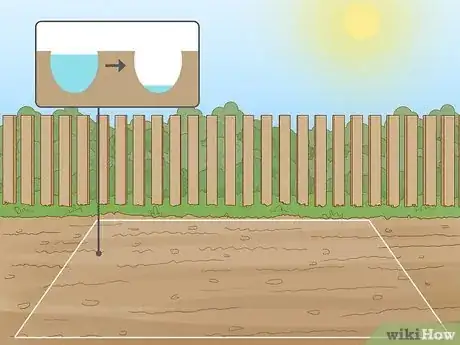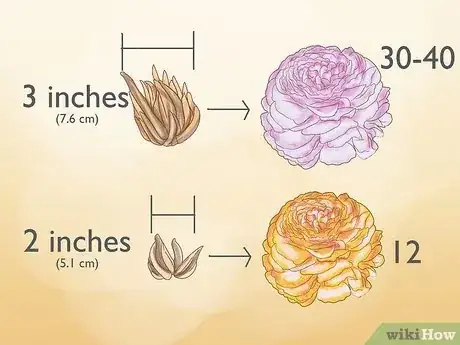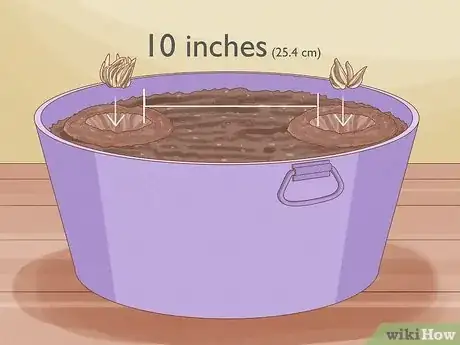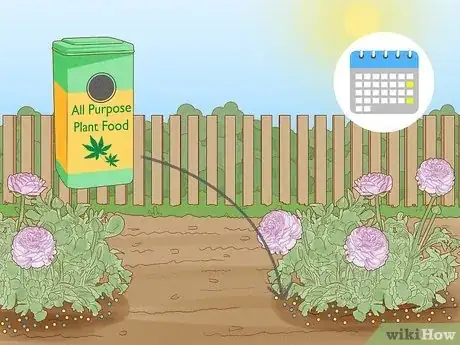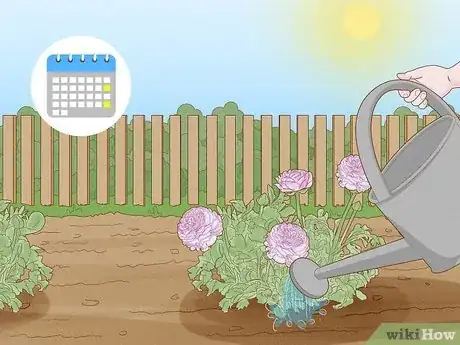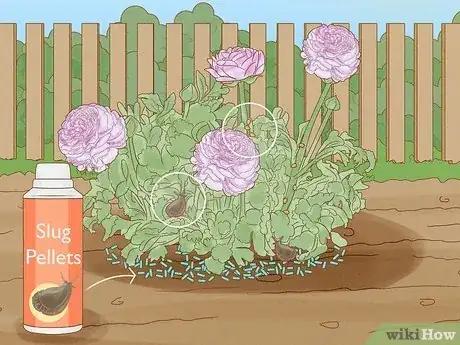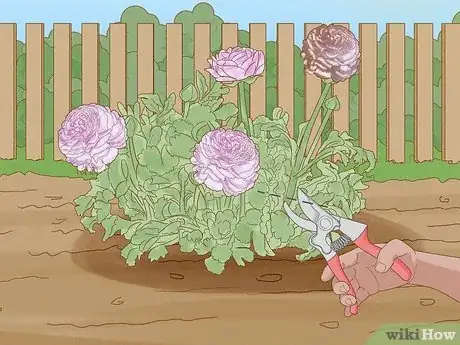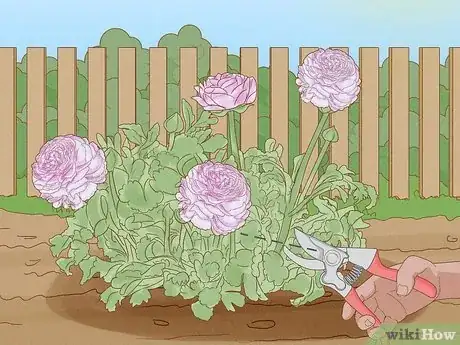wikiHow is a “wiki,” similar to Wikipedia, which means that many of our articles are co-written by multiple authors. To create this article, volunteer authors worked to edit and improve it over time.
wikiHow marks an article as reader-approved once it receives enough positive feedback. This article received 18 testimonials and 100% of readers who voted found it helpful, earning it our reader-approved status.
This article has been viewed 165,135 times.
Learn more...
Ranunculus (Ranunculus asiaticus) refers to a group of several hundred plants that includes buttercups and crowfoots. Frequently sold as cut flowers and a popular garden plant, this family of plants offers brilliantly colored blooms. A number of brightly-colored varieties with multiple layers of petals in a rosette shape are available for planting at home. Most varieties of ranunculus will grow to about 15 inches (38.1 cm) in height. However, to grow beautiful ranunculus you will need to know how to plant them, and care for them after they are planted.
Steps
Planting Ranunculus
-
1Pick out a spot for your ranunculus based on your climate. Ranunculus plants prefer a sunny location but if you are in an especially hot climate they will tolerate some shade. Ranunculus tend not to tolerate heavy frost so if you are planting them in cooler climates it is recommended to store the tubers, which are also know as bulbs, inside for the winter.[1]
- Storing ranunculus tubers will be covered in Step 6 of Method 2 further down in the article.
-
2Find a spot to plant your ranunculus where the soil drains well. Aside from planting your ranunculus in the sun, you should also keep the soil in mind when choosing a spot for your plant. Ranunculus grow well in well-drained soil and prefer rich, sandy ground. Avoid planting your ranunculus in areas where puddles remain long after rainfall, or if you know your soil is heavy clay.[2]
- You can determine if your soil is predominantly clay by squeezing a handful of moist soil in your palm. If it clumps together, you likely have a clay-heavy soil. You can improve soil drainage by mixing your soil with a generous amount of substances such as plant fibers (bark or grass clippings) or well-rotted manure. These ‘soil extras’ will help your ranunculus to grow.
Advertisement -
3Plant your ranunculus from tubers (aka bulbs) if possible. Tubers, or bulbs, are generally the preferred way to grow ranunculus. A tuber is similar to a root; ranunculus tubers look like spiders, claws, or bunches of bananas. Their odd appearance is helpful when it comes to planting. Plant the tuber with the pointed ‘claw’ end or ‘spider’s legs’ facing downwards. To plant your tubers:
- You should plant smaller varieties so that they are about 2 inches (5.1 cm) deep and 5 inches (12.7 cm) apart from other tubers.
- Plant larger varieties, such as Ranunculus Tecolote, up to 12 inches (30.5 cm) apart.
- You don’t need to soak them before planting. It’s best to plant in batches of up to a dozen for maximum effect. Plant as soon as the last frosts have ended, usually in the spring.
- Water the tubers and the ground around them after you have planted them. Watering them will help to settle the soil.
- Do not water until sprouts emerge.
-
4Be aware that you can generally tell how many flowers you will get by looking at the bulb or tuber. The size of the bulb will help indicate the number of flowers it will produce.
- ‘Jumbos’ are the largest at around 3 inches (7.6 cm) diameter and will produce 30-40 flowers.
- Smaller tubers of around 2 inches (5.1 cm) diameter can produce a dozen or so.
-
5Try growing ranunculus from seed if you cannot purchase tubers. Ranunculus can also be grown from seed. It’s best to sow the seeds indoors in September as ranunculus seeds prefer a cool temperature. To plant ranunculus seeds:
- Sow, or place, the seeds into pre-moistened compost that’s lightweight and suitable for seed sowing.
- Do not cover the seeds with soil. Keep the soil moist and out of direct sunlight.
- Maintain the seeds at a temperature of around 70 °F (21 °C) and a little cooler at night. The seeds should germinate, or grow into small plants, in around two to three weeks.
- Wait until the young plants have around half a dozen leaves before transplanting them into larger pots. Protect these young plants from frost and transfer them into outdoor soil in the following spring if so desired.
-
6Consider planting your ranunculus in a container. To plant ranunculus tubers in pots, fill the container about three quarters full of soil. Place the tubers so that they are around 10 inches (25.4 cm) apart from each other and fill the container with soil so that the tubers are covered in about two inches of soil.[3] Water the tubers to settle the soil.
- Remember container plants tend to dry out more easily than plants in the ground, so be mindful of watering over the growing season. Watering will be covered in Step 2 of Method 2.
- Keep in mind that ranunculus plants tend to make a large root system, so don’t crowd them too much in containers.
-
7Keep animals away from the ranunculus, as the flowers are poisonous. All ranunculus plants are poisonous to livestock, and can also be harmful to pets and people. The plants have an unpleasant taste and cause blisters to form in the mouth. This generally means animals avoid eating them unless no other plants are available, which is good if you have deer in your area, but bad if you have pets.
- Consider planting the ranunculus in an area where your pets and livestock can’t reach them, such as a fenced off garden or in a pot (which is covered in Step 6, the previous step, of this section).
Caring for Ranunculus
-
1Feed your plants with ‘plant feed’ every 14 or so days. During the active growing season, which is generally spring through summer, try to support your plants by feeding them every fortnight (which is every 14 days). Start doing this as soon as the first buds appear on the plant.
- A general water-soluble plant feed or one that your rake into the soil is fine. This encourages the plant to produce flowers. You can purchase plant feed at your local gardening supply store.
-
2Water your ranunculus. You should make a point to water your tubers just after planting, as mentioned above. Continue to water your new plants once every 10 to 14 days. When the first foliage, or leaves, appear on your plants, you should try to water them once a week.[4]
- Continue watering your plants once a week until fall comes around. In the fall, the ranunculus will die back, or go dormant, and will not need to be watered. Dormancy is covered more thoroughly in Step 5 of this section.
-
3Defend your ranunculus against pests. Sadly, ranunculus can fall prey to pests like slugs and aphids. Luckily, there are measures you can take to make sure that these pests stay away.
- Combat slugs with slug pellets, which are sprinkled around your ranunculus. You can purchase these pellets at a garden supply store.
- A standard aphid spray or insecticidal soap should be applied if aphid attack occurs.
-
4Remove withered flowerheads with sharp garden scissors. As with many flowering plants, it’s advisable to remove spent flowerheads once they wither (when they dry up and die). This not only makes the plant look tidier, it also encourages other flowers to form and reduces the amount of energy the plant spends on seed formation, which helps preserve its strength.
- Use a sharp pair of scissors to snip off the dead heads as soon as they begin to look scruffy. Try to cut the flower at the base of the stem, which is located in amongst the foliage, or leaves.
-
5Allow your plant to ‘die back’ in the winter. Once the flowering season ends in fall, allow the foliage to die back. Dying back means that the plant becomes dormant until the next flowering season.[5] To encourage the plant to regrow the next season:
- Refrain from cutting the dead growth away before the first frost. You don’t need to water the plant while it is dormant; in fact, these plants do better if they are not watered while they are dormant in the winter.
-
6Store the ranunculus inside during the winter if you live in a climate that gets heavy frost. Ranunculus will tolerate a light frost if left in the ground through a fairly mild winter. If your local climate regularly experiences heavy frost then dig up the tubers and store them in a cool dark place such as a garden shed for the winter.
- Try to avoid bringing them into a heated space like your home as they tend to rot under these conditions.
-
7Understand that many gardeners view ranunculus as annuals. Because of the difficulty establishing ranunculus as perennials (plants which flower year after year), many gardeners just treat them as annuals (plants which flower only one year). However, if you are determined to see yours bloom again, dig up your tubers for the winter, as described in the previous step.
-
8Preserve blooms that you cut. Ranunculus make a beautiful cut flower that generally remains healthy for awhile after being cut if measures are taken to preserve the cut. To preserve the life of cut ranunculus flowers, cut them early in the morning just as the buds are starting to open.
- A good clean cut using a sharp blade will help make the cut clean. Snip the stem at the base of the plant just about the crown and within the foliage. This avoids leaving exposed cut stems.
Community Q&A
-
QuestionHow long before sprouts appear after planting the corms?
 Community AnswerThey should sprout in two or three weeks. It should establish roots within the first week to two weeks, and the first foliage should emerge shortly thereafter.
Community AnswerThey should sprout in two or three weeks. It should establish roots within the first week to two weeks, and the first foliage should emerge shortly thereafter. -
QuestionCan this plant survive in hot climates?
 Community AnswerYes, they originate from the Middle East. However, they only bloom in the spring. You can remove the bulbs from the ground and store them for the winter every year.
Community AnswerYes, they originate from the Middle East. However, they only bloom in the spring. You can remove the bulbs from the ground and store them for the winter every year. -
QuestionCan I leave the tubers in the ground year after year like other bulbs?
 Community AnswerOnly in climates where the ground does not completely freeze during the winter. Otherwise the tubers must be dug up and stored in a cold but frost-free location until the ground thaws in the spring.
Community AnswerOnly in climates where the ground does not completely freeze during the winter. Otherwise the tubers must be dug up and stored in a cold but frost-free location until the ground thaws in the spring.
References
- ↑ http://www.gardenguides.com/77651-care-ranunculus.html
- ↑ http://www.gardenguides.com/77651-care-ranunculus.html
- ↑ http://www.easytogrowbulbs.com/g-21-ranunculus-planting-guide.aspx
- ↑ http://www.gardenguides.com/77651-care-ranunculus.html
- ↑ http://www.easytogrowbulbs.com/g-21-ranunculus-planting-guide.aspx
About This Article
Ranunculus grows from tubers or seeds, and all you need to care for these plants are plenty of sunlight, well-draining soil, and plant feed. Choose a sunny place to plant your ranunculus, as this plant thrives in warm climates. If you live in a location with heavy frosts, store the bulbs inside during the winter to protect them. Make sure that you plant the ranunculus in well-draining soil to keep the roots free from rot. To help your ranunculus thrive, give it plant feed every 2 weeks or so during spring through summer, which is the active growing season. Begin giving the plant a water-soluble feed as soon as the first bulbs appear. Water your ranunculus every 10 to 14 days after planting and then every 7 days when the first leaves appear. You don’t need to water your ranunculus when it’s dormant during fall. For more tips on planting and caring for a ranunculus, like how to preserve blooms that you cut, read on.

